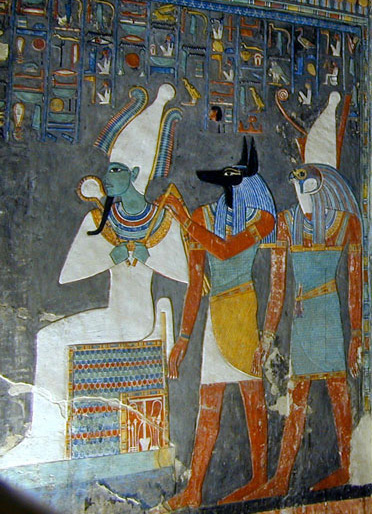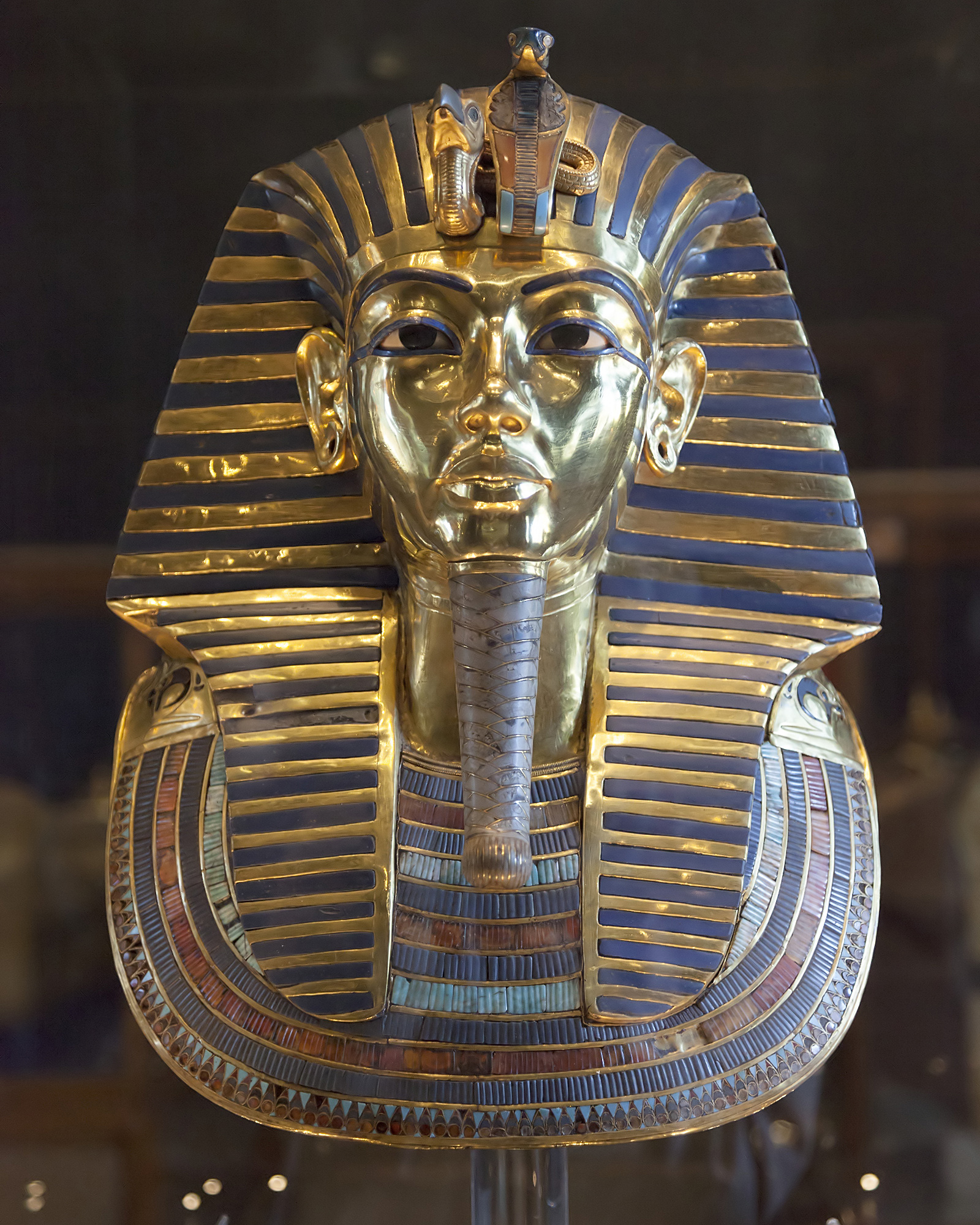|
Senseneb
Senseneb was the mother of Pharaoh Thutmose I in the Eighteenth Dynasty of the early New Kingdom. Attestations Senseneb (sn⸗j-snb, also Seniseneb) bore the title of King's Mother (mwt-nsw) and is therefore thought to have been a commoner. Wadi Halfa, Cairo CG 34006 At Buhen in Wadi Halfa, a sandstone stela fragment dated to Year 1 of Thutmose I, mentions .. jmj-rꜣ ḫꜣst rsjt trj and King's Mother Senseneb (mwt-nsw sn⸗j-snb). She is shown swearing an oath of allegiance as the king's mother on the coronation of her son Thutmose I. Deir el-Bahri PM 122, Mortuary Temple of Hatshepsut At Deir el-Bahri Deir el-Bahari or Dayr al-Bahri (, , ) is a complex of mortuary temples and tombs located on the west bank of the Nile, opposite the city of Luxor, Egypt. This is a part of the Theban Necropolis. History Deir el-Bahari, located on the west ..., Senseneb is also depicted on painted reliefs from the Mortuary Temple of Hatshepsut. Here she has the title ḥnwt-tꜣ ... [...More Info...] [...Related Items...] OR: [Wikipedia] [Google] [Baidu] |
Thutmose I
Thutmose I (sometimes read as Thutmosis or Tuthmosis I, Thothmes in older history works in Latinized Greek; meaning "Thoth is born") was the third pharaoh of the Eighteenth Dynasty of Egypt, 18th Dynasty of History of Ancient Egypt, Egypt. He received the throne after the death of the previous king, Amenhotep I. During his reign, he campaigned deep into the Levant and Nubia, pushing the borders of Egypt farther than ever before in each region. He also built many temples in Egypt, and a tomb for himself in the Valley of the Kings; he is the first king confirmed to have done this (though Amenhotep I may have preceded him). Thutmose I's reign is #Dates and length of reign, generally dated to 1506–1493 BC, but a minority of scholars—who think that astrological observations used to calculate the timeline of ancient Egyptian records, and thus the reign of Thutmose I, were taken from the city of Memphis, Egypt, Memphis rather than from Thebes, Egypt, Thebes—would date his reign to ... [...More Info...] [...Related Items...] OR: [Wikipedia] [Google] [Baidu] |
Deir El-Bahri
Deir el-Bahari or Dayr al-Bahri (, , ) is a complex of mortuary temples and tombs located on the west bank of the Nile, opposite the city of Luxor, Egypt. This is a part of the Theban Necropolis. History Deir el-Bahari, located on the west bank of the Nile at Thebes, Egypt, Thebes (modern Luxor) is a complex of mortuary temples and tombs that has served as a major religious center for over two millennia. Its history begins with the 11th Dynasty when Pharaoh Mentuhotep II (c.2061-2010 BCE) constructed his funerary temple here to commemorate the reunification of Egypt after the First Intermediate Period. Mentuhotep's terraced complex, integrating a royal tomb into a temple platform, pioneered the cliffside temple style later emulated by New Kingdom rulers. Centuries later, the 18th Dynasty queen Hatshepsut erected her famous temple ''Djeser-Djeseru,'' designed by her architect Senenmut, directly beside Mentuhotep's complex. Richly decorated reliefs in Hatshepsut's temple celebr ... [...More Info...] [...Related Items...] OR: [Wikipedia] [Google] [Baidu] |
Eighteenth Dynasty Of Egypt
The Eighteenth Dynasty of Egypt (notated Dynasty XVIII, alternatively 18th Dynasty or Dynasty 18) is classified as the first dynasty of the New Kingdom of Egypt, the era in which ancient Egypt achieved the peak of its power. The Eighteenth Dynasty spanned the period from 1550/1549 to 1292 BC. This dynasty is also known as the Thutmoside Dynasty for the four pharaohs named Thutmose. Several of Egypt's most famous pharaohs were from the Eighteenth Dynasty, including Tutankhamun. Other famous pharaohs of the dynasty include Hatshepsut (c. 1479 BC–1458 BC), the longest-reigning woman pharaoh of an indigenous dynasty, and Akhenaten (c. 1353–1336 BC), the "heretic pharaoh", with his Great Royal Wife, Nefertiti. The Eighteenth Dynasty is unique among Egyptian dynasties in that it had two Queen regnant, queens regnant, women who ruled as sole pharaoh: Hatshepsut and Neferneferuaten, usually identified as Nefertiti. History Early Dynasty XVIII Dynasty XVIII was founded by Ahmo ... [...More Info...] [...Related Items...] OR: [Wikipedia] [Google] [Baidu] |
Ancient Egyptian Religion
Ancient Egyptian religion was a complex system of Polytheism, polytheistic beliefs and rituals that formed an integral part of ancient Egyptian culture. It centered on the Egyptians' interactions with Ancient Egyptian deities, many deities believed to be present and in control of the world. About 1,500 deities are known. Rituals such as prayer and offerings were provided to the gods to gain their favor. Formal religious practice centered on the pharaohs, the rulers of Egypt, believed to possess divine powers by virtue of their positions. They acted as intermediaries between their people and the gods, and were obligated to sustain the gods through rituals and offerings so that they could maintain Ma'at, the order of the cosmos, and repel Isfet (Egyptian mythology), Isfet, which was chaos. The state dedicated enormous resources to religious rituals and to the construction of Egyptian temple, temples. Individuals could interact with the gods for their own purposes, appealing for hel ... [...More Info...] [...Related Items...] OR: [Wikipedia] [Google] [Baidu] |
Pharaoh
Pharaoh (, ; Egyptian language, Egyptian: ''wikt:pr ꜥꜣ, pr ꜥꜣ''; Meroitic language, Meroitic: 𐦲𐦤𐦧, ; Biblical Hebrew: ''Parʿō'') was the title of the monarch of ancient Egypt from the First Dynasty of Egypt, First Dynasty () until the Roman Egypt, annexation of Egypt by the Roman Republic in 30 BCE. However, the equivalent Egyptian language, Egyptian word for "king" was the term used most frequently by the ancient Egyptians for their monarchs, regardless of gender, through the middle of the Eighteenth Dynasty during the New Kingdom of Egypt, New Kingdom. The earliest confirmed instances of "pharaoh" used contemporaneously for a ruler were a letter to Akhenaten (reigned –1336 BCE) or an inscription possibly referring to Thutmose III (–1425 BCE). In the early dynasties, ancient Egyptian kings had as many as ancient Egyptian royal titulary, three titles: the Horus name, Horus, the prenomen (Ancient Egypt), Sedge and Bee (wikt:nswt-bjtj, ''nswt-bjtj''), and ... [...More Info...] [...Related Items...] OR: [Wikipedia] [Google] [Baidu] |
Wadi Halfa
(, , ":wikt:esparto, Esparto Valley") is a city in the Northern (state), Northern state of Sudan on the shores of Lake Nasser, Lake Nubia near the Egypt–Sudan border, border with Egypt. It is the terminus of a rail transport in Sudan, rail line from Khartoum and the point where goods are transferred from rail to ferries going down the lake. As of 2007, the city had a population of 15,725. The city is located amidst numerous ancient Nubian antiquities and was the focus of much archaeological work by teams seeking to save artifacts from the flooding caused by the completion of the Aswan Dam. Climate Wadi Halfa has a hot desert climate (Köppen climate classification ''BWh'') typical of the Nubian Desert. Wadi Halfa receives each year the highest mean amount of bright sunshine, with an extreme value of 4,300 h, which is equal to 97–98 % of possible sunshine. In addition to this, the town receives a mean annual amount of rainfall of . Many years usually pass without any rain fal ... [...More Info...] [...Related Items...] OR: [Wikipedia] [Google] [Baidu] |
Adriaan De Buck
Adriaan de Buck (Oostkapelle, 22 September 1892 – Leiden, 28 October 1959) was an eminent Dutch Egyptologist. From 1939 he was Professor of Egyptology at Universiteit Leiden, Leiden University. Life and work De Buck read theology in Leiden (1911–1916) with Pierre Daniel Chantepie de la Saussaye and William Brede Kristensen. He studied several Semitic languages (among them Arabic), and specialized in ancient Egyptian language, Egyptian which he first read with Pieter Boeser. He then continued his studies in Egyptology in Göttingen and Berlin (1917–1921) with Adolf Erman and Kurt Heinrich Sethe, Kurt Sethe. De Buck was ordained minister in the Dutch Reformed Church and served in the small town of Ursem (1921–1925). On 6 July 1922 he received his doctorate in theology from Leiden University on a thesis titled ''De Egyptische voorstellingen betreffende den oerheuvel'' (“The Egyptian depictions concerning the primeval hill”), supervised by W.B. Kristensen. In 1924 he w ... [...More Info...] [...Related Items...] OR: [Wikipedia] [Google] [Baidu] |
Édouard Naville
Henri Édouard Naville (14 June 1844 – 17 October 1926) was a Swiss archaeologist, Egyptologist and Biblical scholar. Born in Geneva, he studied at the University of Geneva, King's College, London, and the Universities of Bonn, Paris, and Berlin. He was a student of Karl Richard Lepsius and later his literary executor. He first visited Egypt in 1865, where he copied the Horus texts in the temple at Edfu. During the Franco-Prussian War he served as a captain in the Swiss army. His early work concerned the solar texts and the Book of the Dead. In 1882 he was invited to work for the newly founded Egypt Exploration Fund. He excavated a number of sites in the Nile Delta including Tell el-Maskhuta (1882), the Wadi Tumilat (1885–86), Bubastis (1886–89), Tell el-Yahudiyeh (1887), Saft el-Hinna (1887), Ahnas (1890–91), Mendes and Tell el-Muqdam (1892). Many of the objects he found in his Delta excavations are preserved in the Cairo Museum, British Museum, and ... [...More Info...] [...Related Items...] OR: [Wikipedia] [Google] [Baidu] |
16th-century BC Egyptian Women
The 16th century began with the Julian calendar, Julian year 1501 (represented by the Roman numerals MDI) and ended with either the Julian or the Gregorian calendar, Gregorian year 1600 (MDC), depending on the reckoning used (the Gregorian calendar introduced a lapse of 10 days in October 1582). The Renaissance in Italy and Europe saw the emergence of important artists, authors and scientists, and led to the foundation of important subjects which include accounting and political science. Copernicus proposed the Copernican heliocentrism, heliocentric universe, which was met with strong resistance, and Tycho Brahe refuted the theory of celestial spheres through observational measurement of the SN 1572, 1572 appearance of a Milky Way supernova. These events directly challenged the long-held notion of an immutable universe supported by Ptolemy and Aristotle, and led to major revolutions in astronomy and science. Galileo Galilei became a champion of the new sciences, invented the first ... [...More Info...] [...Related Items...] OR: [Wikipedia] [Google] [Baidu] |







